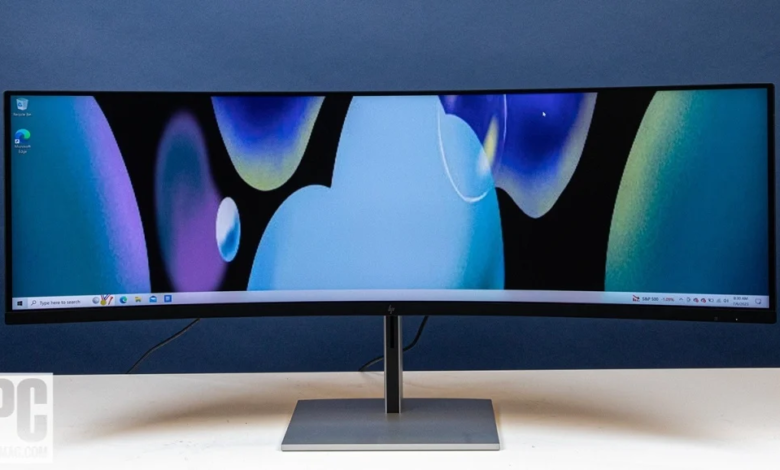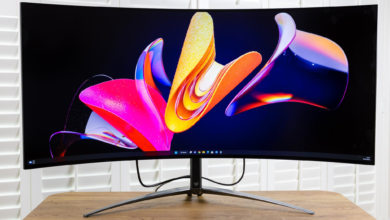The Ultimate Guide to PC Monitors: Reviews and Top Picks for Every Need

The Ultimate Guide to PC Monitors: Reviews and Top Picks for Every Need. Choosing the right PC monitor can dramatically enhance your experience, whether you’re a gamer, professional, or casual user. With so many types, features, and specifications to consider, it’s easy to get overwhelmed. This comprehensive guide covers everything you need to know, from the best monitors for gaming and office work to budget-friendly options and top picks for creative professionals. By the end of this article, you’ll have the knowledge to choose the perfect monitor based on your specific needs.
Introduction to PC Monitor Reviews
When it comes to buying a PC monitor, the options can be overwhelming. From gaming to office work, selecting the right monitor is critical to your overall experience. But with so many factors to consider—resolution, refresh rate, panel type—how do you decide which one is the best for you? This guide breaks down the different types of monitors, their features, and how to pick the perfect one based on your specific needs.
Why Choosing the Right Monitor Matters
Monitors are not one-size-fits-all. The needs of a gamer differ drastically from someone working in graphic design or simply browsing the web. A good monitor can improve your experience, productivity, and even your health. For instance, gaming monitors focus on refresh rates, while office monitors prioritize ergonomics and eye-care technology.
Key Factors to Consider
Before diving into specific recommendations, it’s important to understand the primary factors to keep in mind when shopping for a monitor:
- Resolution: Higher resolutions, such as 1440p or 4K, offer sharper images.
- Refresh Rate: Measured in hertz (Hz), the refresh rate impacts how smoothly images move on the screen.
- Panel Type: IPS, TN, and VA panels all have different strengths and weaknesses.
Types of PC Monitors
Different types of monitors cater to various needs. Let’s break down the most common ones.
LED Monitors
LED monitors are among the most popular due to their bright displays and energy efficiency. They offer vibrant colors and sharp contrasts, making them a versatile option for general use.
IPS Monitors
IPS (In-Plane Switching) monitors are well-known for their superior color accuracy and wide viewing angles. These are ideal for graphic designers and photographers, as they reproduce colors more accurately than other panel types.
Curved Monitors
Curved monitors provide an immersive experience, especially for gamers and video editors. The curve reduces eye strain and allows for a more natural field of view, making them an excellent choice for long hours of use.
Best PC Monitors for Gaming
Gaming monitors have specific requirements to provide the best experience, such as high refresh rates and low input lag.
High Refresh Rate Monitors
For a smooth gaming experience, a monitor with a high refresh rate is crucial. Monitors with 144Hz or 240Hz are ideal for competitive gaming, where every millisecond counts.
Monitors with Low Input Lag
Input lag refers to the delay between a keypress and the action happening on-screen. Monitors with low input lag are essential for fast-paced games, as they ensure quicker reactions and less delay during gameplay.
Best Monitors for Office Work
Office work demands long hours in front of a screen, so comfort and eye-care are key.
Monitors with Eye-Care Technology
Monitors equipped with features like blue light filters and flicker-free technology help reduce eye strain, making them perfect for all-day use.
Ultra-Wide Monitors for Productivity
For multitasking, ultra-wide monitors are a game changer. These monitors allow you to split your screen into multiple windows, boosting productivity and eliminating the need for a dual-monitor setup.
Monitors for Creative Professionals
If you work in graphic design, video editing, or photography, color accuracy and resolution are top priorities.
4K Monitors for Designers
A 4K monitor offers incredible clarity and detail, which is essential for creative professionals who need to work on high-resolution content.
Color Accuracy and Calibration
Creative work requires highly accurate color reproduction. Look for monitors that come pre-calibrated or support professional calibration tools to ensure the best color fidelity.
Budget-Friendly PC Monitors
You don’t have to break the bank to get a decent monitor. There are plenty of affordable options that still offer great performance.
Top Affordable Options
Monitors like the ASUS VP249QGR and AOC 24G2 provide excellent value for their price, with features like high refresh rates and accurate color reproduction.
Performance vs. Price: Where to Compromise
While it’s tempting to go for the highest specs, consider what you really need. For example, if you’re not a gamer, you might not need a monitor with a 240Hz refresh rate.
Monitors with the Best Resolution
Resolution is one of the most important aspects of a monitor, affecting the clarity of images and videos.
1080p Monitors
1080p, also known as Full HD, is the most common resolution for monitors. It’s sufficient for most users, especially for office work, browsing, and casual gaming.
1440p vs. 4K Monitors
If you need sharper images, 1440p (QHD) or 4K (UHD) resolutions offer significantly better detail. 4K monitors are particularly useful for creative professionals and gamers looking for ultra-clear graphics.
Connectivity Options on PC Monitors
A monitor’s connectivity options can affect how versatile it is.
HDMI and DisplayPort
HDMI and DisplayPort are the two most common inputs, offering high-quality video and audio transmission. DisplayPort is often preferred for gaming because it supports higher refresh rates and resolutions.
USB-C Monitors
For those who want an all-in-one solution, USB-C monitors offer charging, data transfer, and display connectivity through a single cable. This is perfect for users with laptops or newer devices.
How Refresh Rate Affects Performance
A higher refresh rate provides smoother motion, which is especially important in gaming and video editing.
60Hz vs. 144Hz vs. 240Hz
While 60Hz is standard for most monitors, 144Hz and 240Hz offer a noticeable improvement in fluidity, particularly for fast-paced activities like gaming.
Adaptive Sync: G-Sync vs. FreeSync
Adaptive sync technologies like G-Sync (NVIDIA) and FreeSync (AMD) help eliminate screen tearing and stuttering, ensuring a smoother gaming experience.
Monitor Size: What’s the Best for You?
Choosing the right monitor size depends on your space and use case.
24-Inch vs. 27-Inch Monitors
For most users, 24-inch monitors offer a good balance between size and desk space. However, if you prefer larger screens for gaming or multitasking, a 27-inch monitor may be more suitable.
Ultra-Wide Monitors: Pros and Cons
Ultra-wide monitors, typically 34 inches or more, provide a wider field of view, which can be great for productivity and gaming, but they also take up more desk space.
Aspect Ratio: Does It Matter?
Aspect ratio determines the shape of your monitor.
Standard 16:9 Monitors
The 16:9 aspect ratio is standard, offering a widescreen experience that works well for most tasks, including gaming, video editing, and general use.
21:9 Ultra-Wide Monitors
For those who want an immersive experience or extra workspace, 21:9 ultra-wide monitors are an excellent choice, though not all games and programs fully support this ratio.
Ergonomics and Adjustable Features
Comfort is key, especially if you spend long hours in front of your monitor.
Tilt and Height Adjustments
Monitors with adjustable stands allow you to tilt, swivel, and raise or lower the screen, ensuring a more ergonomic setup and reducing neck strain.
VESA Mount Compatibility
For those who prefer a clean, minimal desk setup, VESA mounts allow you to attach your monitor to a stand or wall, freeing up space and offering greater flexibility in positioning.
Gaming Monitors with HDR Support
HDR (High Dynamic Range) improves color and contrast, making games and videos look more vibrant.
The Benefits of HDR in Gaming
HDR enhances the gaming experience by offering richer colors, deeper blacks, and brighter highlights, making it a must-have for gamers who prioritize visuals.
Monitors with the Best HDR Performance
Some of the best HDR monitors include the ASUS ROG Swift PG32UQ and LG 27GN950, which offer excellent HDR performance without compromising on refresh rate or resolution.
Monitor Panels: TN, IPS, or VA?
The type of panel you choose significantly affects your monitor’s performance.
Differences Between Each Panel Type
- TN panels are known for their fast response times, making them ideal for gaming.
- IPS panels provide better color accuracy and viewing angles, making them suitable for creative work.
- VA panels offer deep contrasts and are great for movies.
Which Panel is Best for Your Needs?
If you’re a gamer, TN panels might be your best bet. For designers, an IPS panel is ideal. If you watch a lot of movies or need good contrast, go for a VA panel.
Conclusion: Finding the Perfect Monitor for You
Choosing the right PC monitor depends on your specific needs, whether you’re gaming, working, or creating content. By considering factors like resolution, refresh rate, and panel type, you can find the perfect monitor that meets your requirements without breaking the bank.
FAQs
What’s the best refresh rate for gaming monitors?
For gaming, a refresh rate of 144Hz or higher is recommended to ensure smooth and responsive gameplay.
Are ultra-wide monitors better for multitasking?
Yes, ultra-wide monitors provide more screen real estate, allowing you to view multiple windows side by side, making them ideal for multitasking.
How do I choose between 1080p, 1440p, and 4K?
Choose 1080p if you’re on a budget, 1440p for a balance of performance and quality, and 4K if you prioritize the highest image clarity.
What’s the difference between G-Sync and FreeSync?
G-Sync is NVIDIA’s adaptive sync technology, while FreeSync is AMD’s. Both prevent screen tearing, but G-Sync is typically more expensive.
How important is color accuracy for graphic designers?
Color accuracy is crucial for designers. Monitors with IPS panels and factory calibration are ideal for ensuring that your work looks consistent across different screens and print.

